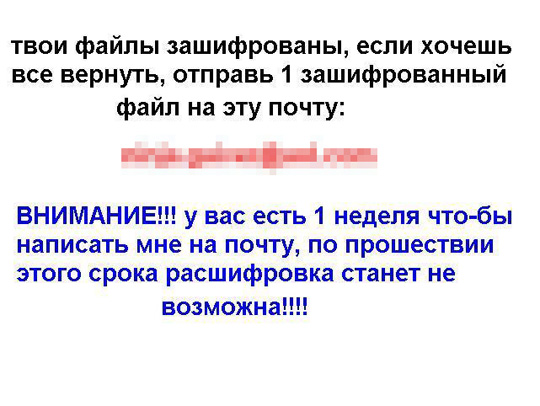RANSOM_CRYPICH.E
Ransom:Win32/Criakl.D (Microsoft); Trojan-Ransom.Win32.Cryakl.ado (Kaspersky); Ransom.TeslaCrypt (Malwarebytes);
Windows


Threat Type: Trojan
Destructiveness: No
Encrypted: Yes
In the wild: Yes
OVERVIEW
This Trojan arrives on a system as a file dropped by other malware or as a file downloaded unknowingly by users when visiting malicious sites.
It modifies the Internet Explorer Zone Settings.
It connects to certain websites to send and receive information.
TECHNICAL DETAILS
Arrival Details
This Trojan arrives on a system as a file dropped by other malware or as a file downloaded unknowingly by users when visiting malicious sites.
Installation
This Trojan drops the following copies of itself into the affected system and executes them:
- %User Temp%\{malware file name}.{malware file extension}
(Note: %User Temp% is the user's temporary folder, where it usually is C:\Documents and Settings\{user name}\Local Settings\Temp on Windows 2000, Windows Server 2003, and Windows XP (32- and 64-bit); C:\Users\{user name}\AppData\Local\Temp on Windows Vista (32- and 64-bit), Windows 7 (32- and 64-bit), Windows 8 (32- and 64-bit), Windows 8.1 (32- and 64-bit), Windows Server 2008, and Windows Server 2012.)
It drops the following files:
- %User Temp%\desk.jpg
- %User Temp%\desk.bmp
- %Program Files%\{random file name}.{random file extension} - contains data to be sent to the C&C
- %User Temp%\ZDAVX.bat - deletes %User Temp%\{malware file name}.{malware file extension} and deletes itself afterwards
(Note: %User Temp% is the user's temporary folder, where it usually is C:\Documents and Settings\{user name}\Local Settings\Temp on Windows 2000, Windows Server 2003, and Windows XP (32- and 64-bit); C:\Users\{user name}\AppData\Local\Temp on Windows Vista (32- and 64-bit), Windows 7 (32- and 64-bit), Windows 8 (32- and 64-bit), Windows 8.1 (32- and 64-bit), Windows Server 2008, and Windows Server 2012.. %Program Files% is the Program Files folder, where it usually is C:\Program Files on all Windows operating system versions; C:\Program Files (x86) for 32-bit applications running on Windows 64-bit operating systems.)
It drops the following copies of itself into the affected system:
- %Program Files%\{malware file name}.{malware file extension}
(Note: %Program Files% is the Program Files folder, where it usually is C:\Program Files on all Windows operating system versions; C:\Program Files (x86) for 32-bit applications running on Windows 64-bit operating systems.)
It terminates the execution of the copy it initially executed and executes the copy it drops instead.
Autostart Technique
This Trojan adds the following registry entries to enable its automatic execution at every system startup:
HKEY_LOCAL_MACHINE\Software\Microsoft\
Windows\CurrentVersion\Run
pr = "%Program Files%\{malware file name}.{malware file extension}"
Other System Modifications
This Trojan modifies the following registry entries:
HKEY_LOCAL_MACHINE\Control Panel\Desktop
TileWallpaper = "0"
(Note: The default value data of the said registry entry is "{User Preference}".)
HKEY_LOCAL_MACHINE\Control Panel\Desktop
Wallpaper = "%User Temp%\desk.bmp"
(Note: The default value data of the said registry entry is "{User Preference}".)
It sets the system's desktop wallpaper to the following image:
Web Browser Home Page and Search Page Modification
This Trojan modifies the Internet Explorer Zone Settings.
Information Theft
This Trojan gathers the following data:
- Computer name
- Machine GUID
Other Details
This Trojan connects to the following website to send and receive information:
- http://{BLOCKED}tekhno.com/inst.php
It encrypts files with the following extensions:
- accdb
- abf
- a3d
- asm
- fbx
- fbw
- fbk
- fdb
- fbf
- max
- m3d
- dbf
- ldf
- keystore
- iv2i
- gbk
- gho
- sn1
- sna
- spf
- sr2
- srf
- srw
- tis
- tbl
- x3f
- ods
- pef
- pptm
- txt
- pst
- ptx
- pz3
- mp3
- odp
- qic
- wps
- r3d
- rwl
- rx2
- p12
- sbs
- sldasm
- wps
- sldprt
- odc
- odb
- old
- nbd
- nx1
- nrw
- orf
- ppt
- mov
- mpeg
- csv
- mdb
- cer
- arj
- ods
- mkv
- avi
- odt
- docx
- gzip
- m2v
- cpt
- raw
- cdr
- cdx
- 1cd
- 3gp
- 7z
- rar
- db3
- zip
- xlsx
- xls
- rtf
- doc
- jpeg
- jpg
It renames encrypted files using the following names:
- email-ninja.gaiver@aol.com.ver-CL 1.0.0.0.id-{content of %Program Files%\{random file name}.{random file extension}}.randomname-{random strings}.cbf
NOTES:
This Trojan traverses the following drives to encrypt files:
- d:\
- e:\
- f:\
- g:\
- h:\
- i:\
- j:\
- k:\
- l:\
- m:\
- n:\
- o:\
- q:\
- r:\
- s:\
- t:\
- u:\
- v:\
- w:\
- x:\
- y:\
- z:\
SOLUTION
Step 1
Before doing any scans, Windows XP, Windows Vista, and Windows 7 users must disable System Restore to allow full scanning of their computers.
Step 2
Note that not all files, folders, and registry keys and entries are installed on your computer during this malware's/spyware's/grayware's execution. This may be due to incomplete installation or other operating system conditions. If you do not find the same files/folders/registry information, please proceed to the next step.
Step 3
Reset your Desktop properties
Step 4
Reset Internet security settings
Step 5
Search and delete these files
- %User Temp%\desk.jpg
- %User Temp%\desk.bmp
- %Program Files%\{random file name}.{random file extension}
- %User Temp%\ZDAVX.bat
Step 6
Scan your computer with your Trend Micro product to delete files detected as RANSOM_CRYPICH.E. If the detected files have already been cleaned, deleted, or quarantined by your Trend Micro product, no further step is required. You may opt to simply delete the quarantined files. Please check this Knowledge Base page for more information.
NOTES:
Restore the encrypted files by this malware from backup.
Did this description help? Tell us how we did.


